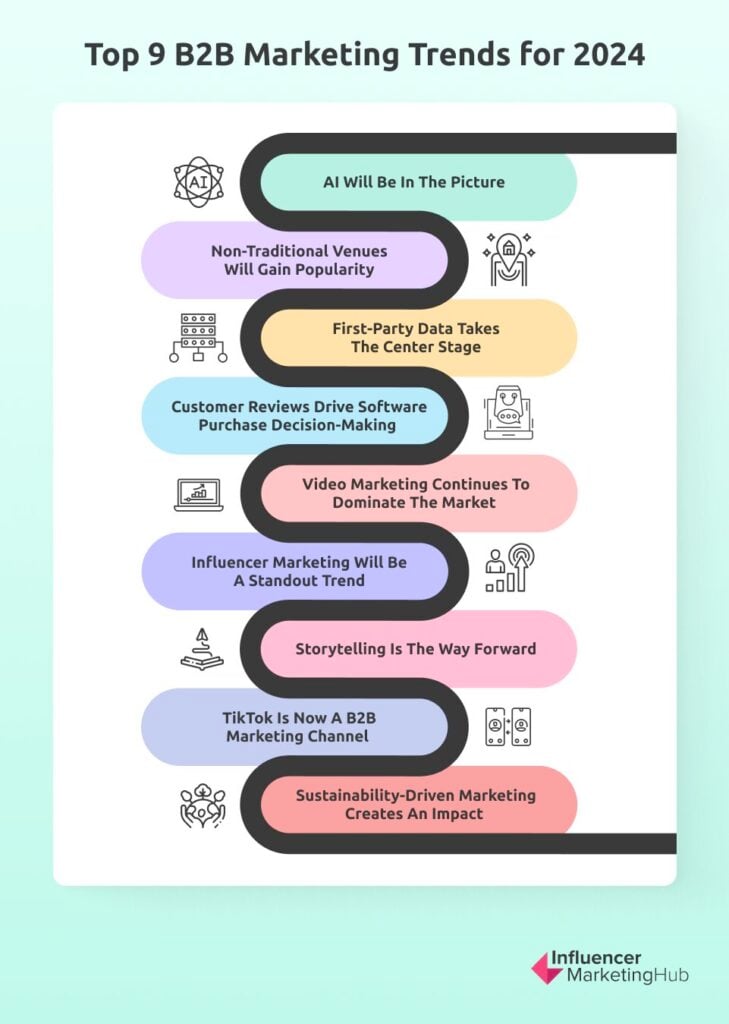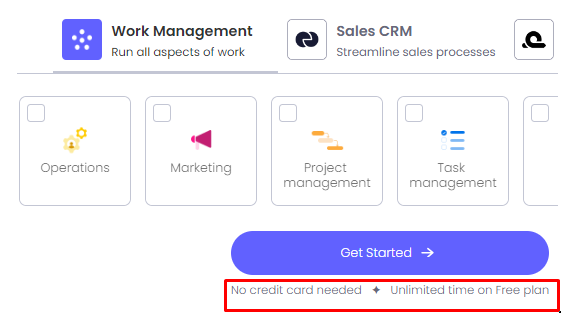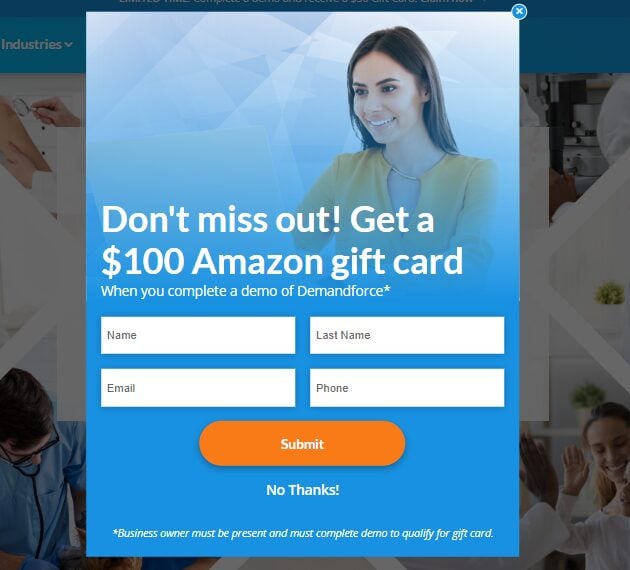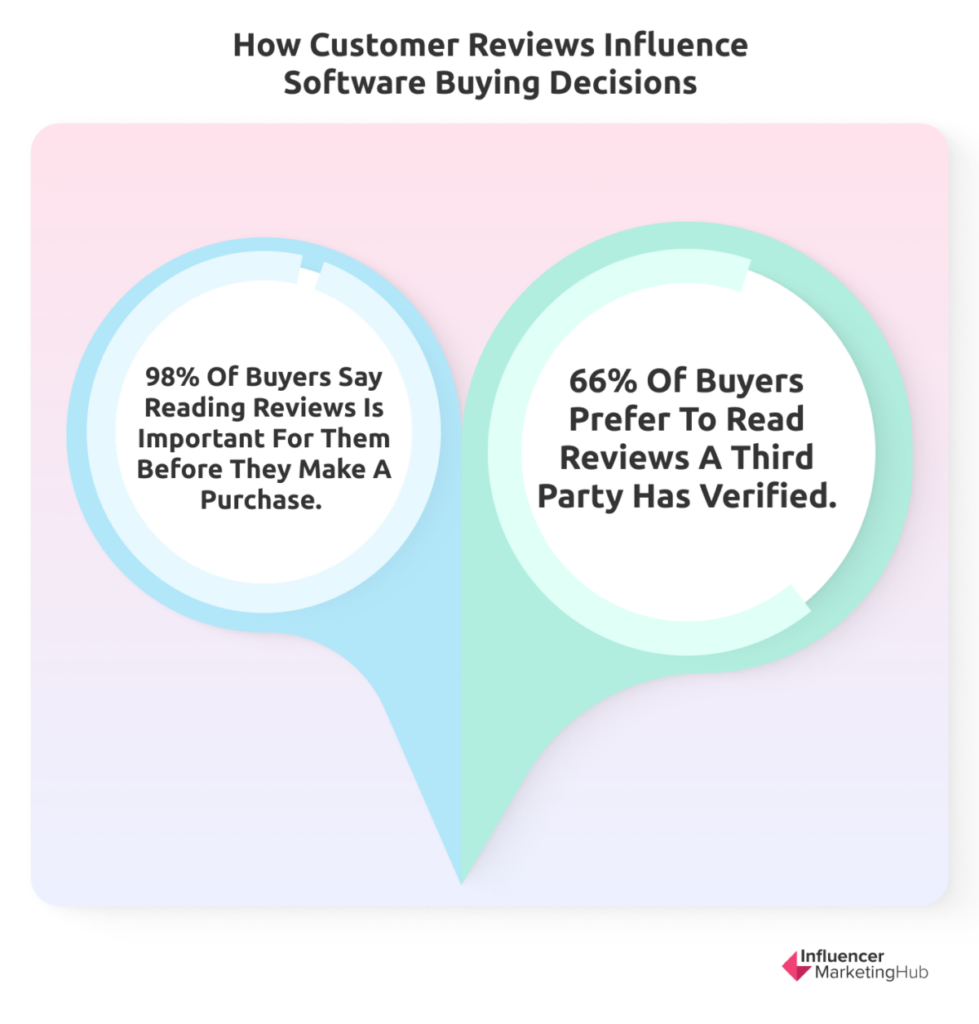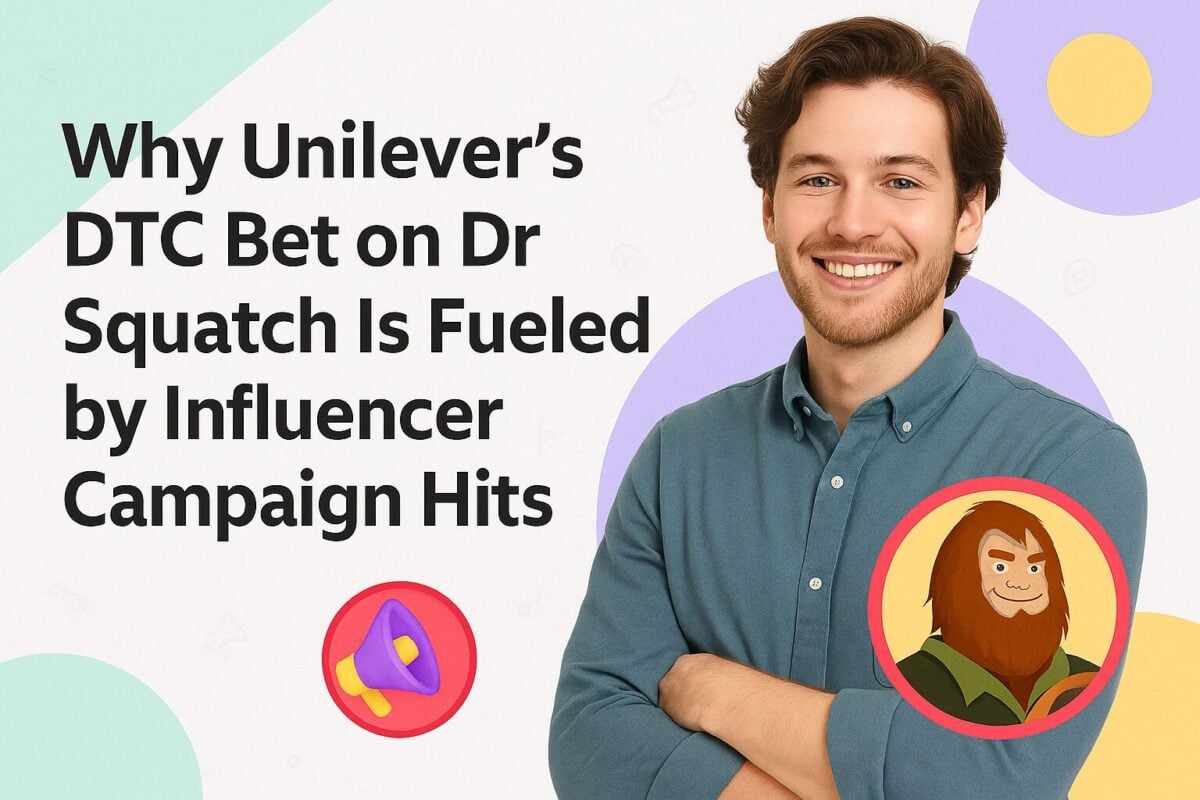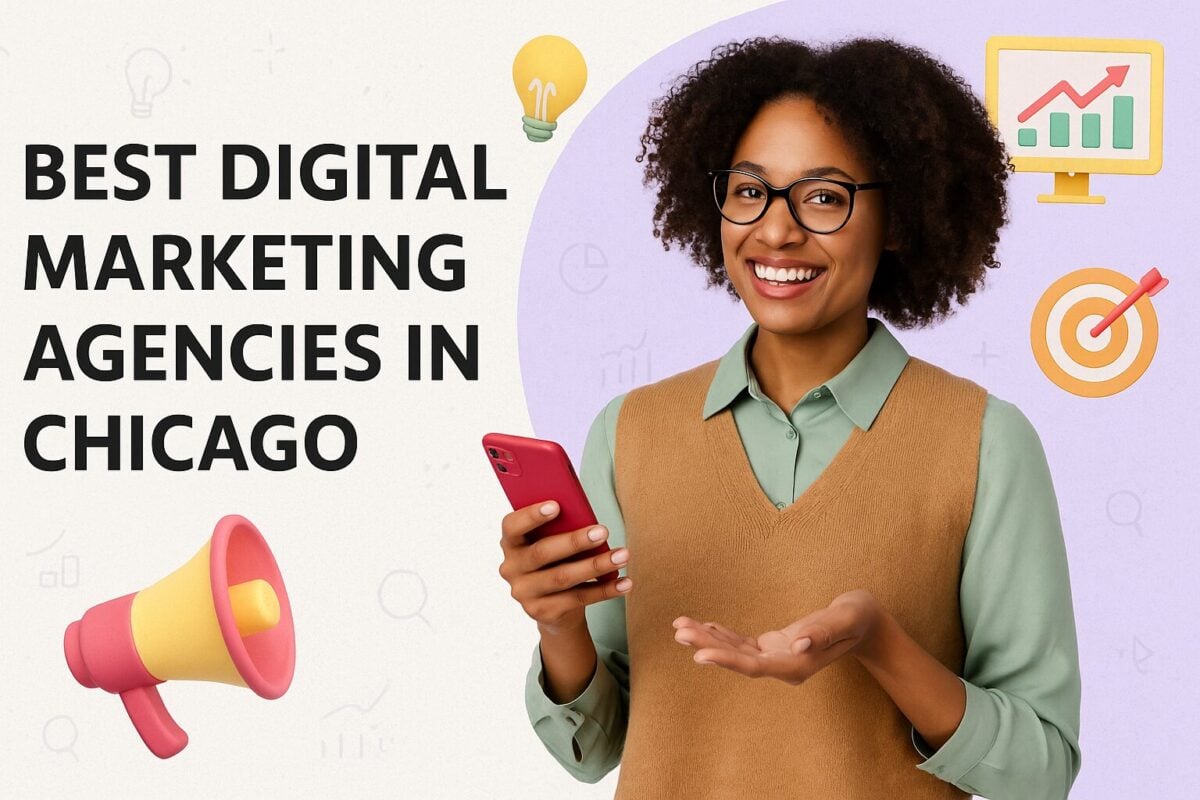The landscape of business-to-business (B2B) marketing has changed a lot in the past few years. Old strategies and tactics are no longer as effective with the advent of AI and personalization. The old tech is being replaced by new, more efficient ways of reaching potential clients.
We took it upon ourselves to explore some of the latest B2B marketing trends that are expected to shape the industry in 2024.
We heard what industry leaders were saying on X and LinkedIn, read some recent data, and put together a list of some must-follow B2B marketing trends.
9 B2B Marketing Trends You Can't Miss in 2024:
- 1. AI Will Be In the Picture
- 2. Non-Traditional Venues Will Gain Popularity
- 3. First-Party Data Takes the Center Stage
- 4. Customer Reviews Drive Software Purchase Decision-Making
- 5. Video Marketing Continues to Dominate the Market
- 6. Influencer Marketing Will Be a Standout Trend
- 7. Storytelling Is the Way Forward
- 8. TikTok Is Now a B2B Marketing Channel
- 9. Sustainability-Driven Marketing Creates an Impact
What Is B2B Marketing?
Before we dive into the latest trends, let's quickly recap what B2B marketing is all about.
B2B marketing, short for business-to-business marketing, involves promoting and selling products or services to other businesses rather than individual consumers.
Unlike business-to-consumer (B2C) marketing, B2B marketing has longer sales cycles. The decision-making process is also more complex since businesses typically have multiple decision-makers involved.
Also, while B2C marketing usually relies on emotions and impulse buying, B2B marketing is more rational and data-driven. All the trends we discuss later will keep these key differences in mind.
9 B2B Marketing Trends to Follow in 2024
It's possible that not all of these trends may apply to you. However, these are the general B2B marketing trends expected to dominate the industry in 2024.
Just pick the ones that work for your business.
1. AI Will Be In the Picture
Well, AI has already been in the picture. But expect it to be a bigger contributor in B2B marketing campaigns in 2024.
The search engine giant Google has taken the lead in this area. In 2023, Google came out with its AI-powered ads.
While these ads have plenty of cool features, the AI-powered asset creation tool is the most exciting. All you have to do is give the tool a few prompts, and Performance Max will generate custom text, video, and image for your ad.
Google says that its ads solutions
Google isn't the only platform using AI in its advertising solutions. Facebook has also introduced Advantage+, which uses ''machine learning to help you reach valuable audiences with less setup time and greater efficiency.''
Similarly, TikTok has also launched its Creative Assistant, which is '' designed to support your video creation journey, helping you to brainstorm ideas, understand best practices, uncover trends, and find inspiration.''
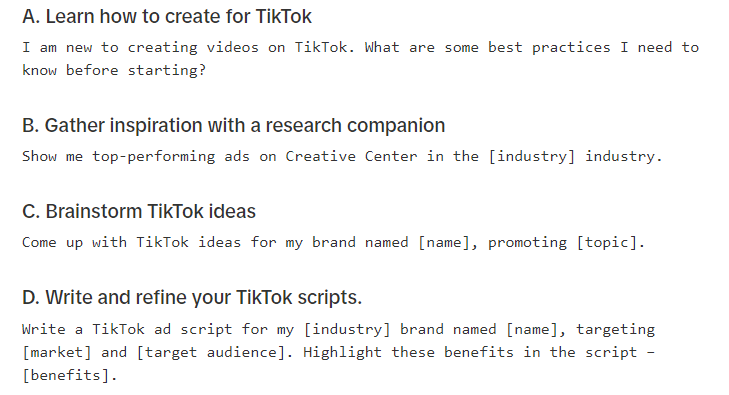
Source: tiktok.com
With every platform introducing some version of AI-powered advertising, it's safe to say that in 2024, AI will be an essential component in B2B marketing campaigns.
How to Implement?
Simply hop on to the bandwagon. Give every AI-powered feature a try, but don't rely on it fully yet. Most of these tools are in their infancy and still need time to develop.
However, completely ignoring them can mean losing out on a competitive edge. So, give them a chance and use your human intuition to make the necessary tweaks.
2. Non-Traditional Venues Will Gain Popularity
B2B event venues usually include conference halls, exhibition centers, and hotels. However, this year, things are expected to change slightly.
Jon Frost, the Founder & President at Trademark Event Production, says,
Basically, B2B marketers will attempt to create unique and memorable experiences. So, instead of the good old conference hall, we might see events in enigmatic locations like museums and parks.
Case Study: Lean Startup hosted its networking event with a greater focus on guest interactions. They had unique experiences, such as an evening planned for the guests at the Mob Museum and a party at the container park.
How to Implement?
Come up with creative ideas to make your events more interesting. For example, instead of hosting a traditional conference, you could have an outdoor event at a park where attendees can use your product in real-life scenarios.
If possible, host events at unique venues like art galleries or historical buildings. Also, give the kind of merch to attendees that they can keep as a memento.
For example, you could give the attendees a customized deck of cards, but with a twist — each card has a marketing tip or pun written on it.
3. First-Party Data Takes the Center Stage
The era of third-party cookies is about to be over. In 2023, Google announced that,
The same year, Google made it clear that "Chrome will ramp up third-party cookie restrictions to 100% of users from H2 2024."
So, it's clear. B2B marketers will have to focus on collecting first-party data now. For that, you must be familiar with ethical data practices and the best tools for data collection.
One way of collecting first-party data is by building an email list. These individuals have willingly given you their details so you can market to them directly.
However, you'll most likely have to offer an incentive in exchange for a client's email address. For example, you could offer them a free trial for an unlimited period of time if they sign up with their email address.
That's what Monday.com does.
Or, you can give a discount or offer. Demandforce gives you new subscribers a $100 Amazon gift card for completing their demo.
Alternatively, you can host a giveaway or contest. Basically, you offer a prize, and people have to sign up with their email addresses to enter. The prize amount will be worth spending, considering the potential revenue you'll make from the email addresses collected.
You can also offer gated content to collect email addresses.
Let's say you're an SEO agency. You have created a 2024 State of SEO report. Give a sneak peak of the report on your website. Ask visitors to sign up with their email addresses for the full report.
CX Network does this with its "2024 Customer Service Trends Report." You can see a brief description on the report on their website.
But if you have to download a copy, you'll have to enter your business email.
Similarly, Gartner also requires you to enter your work email to download its "2024 Top Customer Service Priorities." Both companies will later use these emails to market their services to businesses.
How to Implement?
Brush up your first-party data collection strategy. In one of Google's surveys, the search engine found that 80% of consumers are worried about their online privacy.
Going forward, you'll have to be transparent about the data you collect, its usage, and security. The good news is customers are not as reluctant to share their data as you might think they are.
A Boston Consulting Group report found that 90% of consumers will share their personal information with businesses if they get a good incentive, like more convenience.
Case Study 1: Use Kia as an example of how you can improve conversion rates by using first-party data. The company's first-party data strategy led to a four times higher conversion rates and 55% rise in new-user engagement.
Case Study 2: Zoe Financial is a wealth platform that uses HubSpot to store its first-party data. The company used insights from this data to drive its Google Ads campaign. The result? 60% of sales in the company's most valuable client segment.
If you want to learn more about activating insights from first-party data to drive growth, Google has a helpful guide on the subject.
4. Customer Reviews Drive Software Purchase Decision-Making
According to Gartner's 2024 Global Software Buying Trends Report, 61% of business leaders have plans to increase their tech spending in 2024. As a result, there will be a spike in software solution purchasing.
Customer reviews will play a huge role in shaping these purchase decisions. In today's time, a customer review is not just a piece of feedback.
It's a powerful tool that can make or break a software's reputation. Customers won't just be looking at any other testimonials you show them. Instead, they're more likely to trust verified reviews.
Gartner's report also found that:
- 98% of buyers say reading reviews is important for them before they make a purchase.
- 66% of buyers prefer to read reviews a third party has verified.
Customers are becoming more wary of inauthentic reviews. You'll have to take active steps to ensure that your reviews are genuine.
How to Implement?
First, make sure your satisfied customers are leaving reviews. Encourage them to share their experiences. One way to do this is by making the review leaving process super simple.
You can also offer an incentive like 10% off next month's subscription for leaving a review.
Make sure to keep refreshing your reviews. A review from 2019 won't be as effective as the one from the current year. People want to read about recent experiences to get a sense of the current state of your software.
To verify reviews, use a service like Gartner Digital Markets. It will verify all your reviews on Software Advice, UpCity, GetApp, and Capterra to ensure authenticity.
Another thing you can do on your side is engage with reviews. Even if it's a negative review, respond to it and address whatever issue the customer is facing.
Last but not least, use positive reviews in marketing. Show them on your website and social media pages. Also, add them to your email campaigns, such as a customer success story in your newsletter.
5. Video Marketing Continues to Dominate the Market
Video content already made it big in 2023. But going forward, we'll see it get even bigger.
Kyle Denhoff, Director of Marketing at HubSpot, says, "There are two changes in the market indicating a need for more video content. First, the search landscape is being disrupted by AI. Second, we're seeing a shift to a video-first consumption of content for audiences."
Wistia's State of Video Report 2024 shows that longer videos still get more plays. The play rate for a video over 60 minutes is 58%, compared to 50% for videos that are 30 to 60 minutes long. Shorter videos under 1 minute get 23% plays.
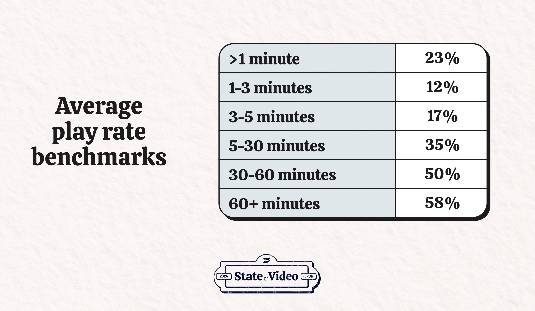
Source: wistia.com
For B2B marketers, these longer videos could be webinars. Experts on X are confident that webinars are still effective for B2B marketing. They have resulted in 56% increase in demo requests and interactions have also risen by 8% year on year.
Webinars still work for #B2Bmarketing
-interactions increased by 8% y/y
-up by 20% since 2021
-yield a 4x increase in requests for a quote on content hubs
-56% increase in requests for a demo in the webinar channelhttps://t.co/pYSiyPM7bqvia @marketingcharts pic.twitter.com/kxAhFTyIzz
— Frank Strong ??✒️? (@Frank_Strong) April 3, 2024
Apart from webinars, longer videos can also be in the form of explainer videos or product demos. These types of videos give more time to explain complex concepts and showcase product features in detail, garnering more interest and engagement from potential customers.
However, merely creating videos won't be enough. You'll also have to add triggers for viewers to take action.
Wistia's report found that 41% of businesses add CTAs, email capture forms, and annotation links to their videos. You should do the same.
How to Implement?
There are many ways to go about increasing conversions with video marketing:
- Add a CTA at the end of your video with a direct link to your product or service.
- Create a sense of urgency with limited-time offers or promotions in the video.
- Use shorter videos as teasers, and then direct viewers to a longer video for more information or a demo.
- Use interactive elements like quizzes within your video to engage viewers.
- Implement personalized videos for specific target audiences to increase relevance. For example, send a personalized demo video to a potential client based on their industry or specific pain points.
6. Influencer Marketing Will Be a Standout Trend
When it comes to B2B marketing, many of us don't immediately think of influencer marketing. However, in 2024, this will be relevant.
Danielle Wiley, the Chief Executive Officer at Sway Group, says,
But who are influencers in the B2B world? In the B2B sense, influencers are industry experts and thought leaders who have a strong presence on social media platforms and are highly respected in their respective fields.
These individuals' voices are already respected. Marketers and decision-makers from other businesses are likely to trust and listen to them since they know what they're talking about.
Where do you find these influencers?
The first stop is social media platforms such as LinkedIn and Twitter. Industry-specific blogs and websites could also be prime spots to find these figures.
Let's take Jesse Wisnewski as an example. He's a marketing executive and the co-author of an industry-leading book, "Read to Lead.''
Come join our marketing team @PhoneBurner.
DM's open.
Hit me up if you have any questions. https://t.co/lDCa5Ae1M5
— Jesse Wisnewski (@thejessew) November 10, 2021
Put briefly, his opinions matter.
His expertise is in content marketing, which means he could be an influencer in the space. Let's say you've created a tool for businesses to improve their content using an AI algorithm.
If Jesse were to try your product and praise it on his social media, you've effectively leveraged influencer marketing. His 20k+ followers are now aware of your product, and you've likely earned their trust by association with Jesse.
How to Implement?
Look for influencers in your industry. Think about the content areas that are related to your product and search for experts in those fields.
Besides LinkedIn and X, influencers could also be found through various professional associations or events. Similarly, business leaders could also be influencers.
7. Storytelling Is the Way Forward
The old drill of finding a pain point and then pitching your product is outdated.
People are now more interested in stories.
Your clients want to know how you've helped someone in their shoes. What challenges they were facing, and how your product resolved them?
In short, people want to hear the stories behind a product rather than just the technicalities. Shannon Tucker, the Vice President at Next PR, explains that,
Case Study: A few years ago, BLP, a law firm that advises financial institutions, created a series of videos called "cautionary tales,'' in which they explained what could happen to bankers who do not follow regulatory advice. Besides videos, the company also created accompanying reports that looked like bank notes, quizzes, infographics, and checklists. The approach helped BLP generate 515% more leads than average.
How to Implement?
Don't limit yourself to the functionalities of your product. Get creative. Think of a story that can be related to your product and the values you bring with it.
Experiment with different forms of storytelling, such as videos, blogs, social media posts, and webinars. You can also use industry puns, stereotypes, and pop culture references to make your story more catchy.
8. TikTok Is Now a B2B Marketing Channel
There was a time when B2B marketers wouldn't consider using TikTok as a marketing channel. But oh, how the times have changed.
The elder Gen Z-ers (commonly known as Zoomers) and the younger Millennials are now in their 20s. They're graduating college and starting their professional lives.
So, they're the ones making the purchasing decisions in many B2B companies. And they're also avid users of TikTok. In fact, GenZ makes up 44.7% of all TikTok user base in the US.
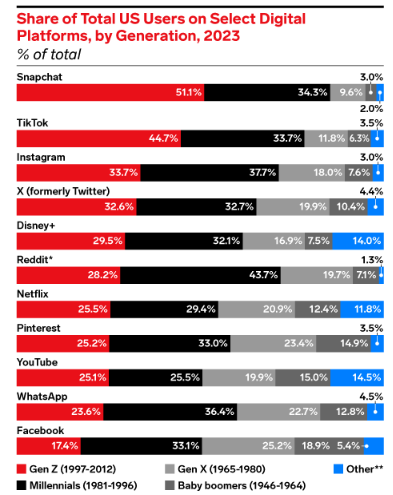
Source: emarketer.com
Although TikTok now has a 10-minute video feature, it's still predominantly known for its short-form video content. You could use the platform to create engaging content around your product or service, targeting the younger generation of decision-makers.
How to Implement?
There are three ways to leverage TikTok.
One, you can run ads on TikTok. As mentioned, TikTok now has an AI-enabled virtual assistant for your ad campaigns. It also allows you to create custom audiences for better targeting.
You can also make good content that goes viral organically. For example, Mailchimp has a TikTok account where they share marketing hacks and tips. Some of their videos have over 100,000 views.
@mailchimp
Hootsuite's TikTok account is even more popular. They use their owl mascot to create educational content for companies. Plus, they maintain relatability by following viral TikTok trends and collaborating with other companies.
@hootsuite
The third method is collaborating with popular TikTok creators. You can sponsor their content or offer them your product for review, reaching a larger audience through their influence.
9. Sustainability-Driven Marketing Creates an Impact
The current generation is passionate about social and environmental issues, and they expect the same from the companies they engage with. In 2024, B2B marketers will have to collaborate with nonprofits and NGOs to support sustainability causes.
In B2B, your customer is also a business. But their customer could want them to be socially responsible.
For instance, if you run an agency that implements software for retailers, your client is a retailer. But their customer is a person who cares about the carbon footprint of their shopping habits.
So, the retailer wants to work with a sustainability-focused software provider to meet their customers' demands. That should be you.
Case Study: Autodesk Inc., a design company offering services to construction, manufacturing, architecture, and engineering clients, is known for its sustainable designs. The company powers its employee work from home, events, cloud services, and facilities with 100% renewable energy. They have also neutralized their greenhouse emissions consecutively for two years. These initiatives make Autodesk a suitable partner for clients who prioritize sustainability.
How to Implement?
Select a social cause that aligns with your business values.
For example, as a software provider, you can partner with an organization that plants trees for every package sold. Then, create content and campaigns highlighting your partnership and the impact you are making together.
Customers with similar values will be likely to engage with your business.
Conclusion
With that, we've come to the end of our list of the B2B marketing trends for 2024. You can now decide where you want to start.
We'd recommend integrating TikTok into your marketing channels and bringing influencers on board. Invest in video marketing and make it personalized.
More importantly, create a relatable story around your brand so that customers can connect with you.
